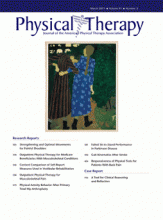Abstract
Background Shoulder pain is a common problem after spinal cord injury (SCI), with negative effects on daily activities and quality of life (QOL).
Objective The purpose of this study was to determine the effect of an exercise program and instruction to optimize performance of upper-extremity tasks on shoulder pain in people with paraplegia from SCI.
Methods/Design Eighty individuals with paraplegia from SCI and shoulder pain were randomly assigned to receive either an exercise/movement optimization intervention or an attention control intervention. The exercise/movement optimization intervention consisted of a 12-week home-based program of shoulder strengthening and stretching exercises, along with recommendations on how to optimize the movement technique of transfers, raises, and wheelchair propulsion. The attention control group viewed a 1-hour educational video. Outcome measures of shoulder pain, muscle strength (force-generating capacity), activity, and QOL were assessed at baseline, immediately after intervention, and 4 weeks later.
Results Shoulder pain, as measured with the Wheelchair User's Shoulder Pain Index, decreased to one third of baseline levels after the intervention in the exercise/movement optimization group, but remained unchanged in the attention control group. Shoulder torques, most 36-Item Short-Form Health Survey questionnaire (SF-36) subscale scores, and QOL scores also were improved in the exercise/movement optimization group, but not in the attention control group. Improvements were maintained at the 4-week follow-up assessment.
Limitations Many of the outcome measures were self-reported, and the participant dropout rate was high in both groups. Additional studies are needed to determine whether the results of this study can be generalized to individuals with tetraplegia.
Conclusions This home-based intervention was effective in reducing long-standing shoulder pain in people with SCI. The reduction in pain was associated with improvements in muscle strength and health-related and overall QOL.
Footnotes
Dr Mulroy, Ms Thompson, Dr Kemp, Dr Newsam, Ms Haubert, Ms Eberly, Dr Ge, Dr Azen, Dr Winstein, and Dr Gordon provided concept/idea/research design. Dr Mulroy, Dr Kemp, Dr Hatchett, Dr Ge, and Dr Azen provided writing. Dr Mulroy, Dr Newsam, Ms Lupold, Ms Haubert, and Ms Eberly provided data collection. Dr Mulroy, Dr Hatchett, Dr Ge, Dr Azen, and Dr Gordon provided data analysis. Dr Mulroy, Dr Hatchett, Dr Newsam, Ms Lupold, Ms Haubert, Ms Eberly, Dr Winstein, and Dr Gordon provided project management. Dr Kemp, Dr Winstein, and Dr Gordon provided fund procurement. Dr Mulroy provided facilities/equipment. Dr Mulroy and Dr Gordon provided institutional liaisons. Ms Thompson, Dr Kemp, Dr Hatchett, Dr Newsam, Ms Haubert, Ms Eberly, Dr Azen, Dr Winstein, and Dr Gordon provided consultation (including review of manuscript before submission).
The authors acknowledge the Physical Therapy Clinical Research Network (PTClinResNet). The principal investigator was Carolee J. Winstein, PT, PhD, FAPTA, and the co-principal investigator was James Gordon, PT, EdD, FAPTA (both at University of Southern California, Los Angeles, California). Project principal and co-principal investigators were: David A. Brown, PT, PhD (Northwestern University, Chicago, Illinois); Sara J. Mulroy, PT, PhD, and Bryan Kemp, PhD (Rancho Los Amigos National Rehabilitation Center, Downey, California); Loretta M. Knutson, PT, PhD, PCS (Missouri State University, Springfield, Missouri); Eileen G. Fowler, PT, PhD (University of California, Los Angeles, Los Angeles, California); and Sharon K. DeMuth, PT, DPT, Kornelia Kulig, PT, PhD, and Katherine J. Sullivan, PT, PhD (University of Southern California). The Data Management Center was located at University of Southern California and is directed by Stanley P. Azen, PhD. The 4-member Data Safety and Monitoring Committee were: Nancy Byl, PT, PhD, FAPTA, Chair (University of California, San Francisco, San Francisco, California), Hugh G. Watts, MD (Shriners' Hospital for Children—LA Unit, Los Angeles, California), June Isaacson Kailes, MSW (Western University of Health Sciences, Pomona, California), and Anny Xiang, PhD (University of Southern California).
Parts of this protocol and data were presented at the American Spinal Injury Association Instructional Course; May 2005; Dallas, Texas; the Combined Sections Meeting of the American Physical Therapy Association; February 23–27, 2005; New Orleans, Louisiana; the Combined Sections Meeting of the American Physical Therapy Association; February 14–18, 2007; Boston, Massachusetts; and the California Physical Therapy Association Annual Conference; October 21–22, 2004; Anaheim, California.
This study was supported by grants from the Foundation for Physical Therapy (American Physical Therapy Association) to establish the PTClinResNet and the National Institute on Disability and Rehabilitation Research through the Research and Rehabilitation Training Center on Aging With a Disability (grant H133B081002). The PTClinResNet is a clinical research network to evaluate the efficacy of physical therapist practice.
Trial registration: ClinicalTrials.gov Identifier: NCT00461474.
- Received May 21, 2010.
- Accepted October 31, 2010.












